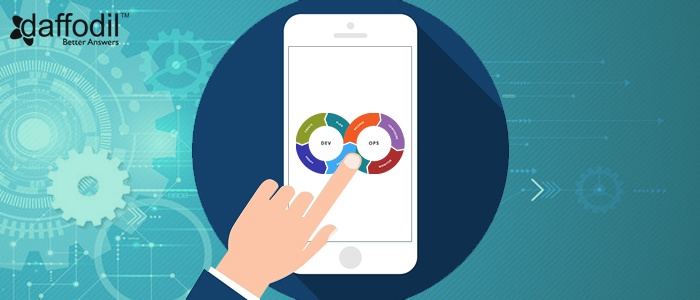
Almost half-decade back, businesses experienced a massive shift in how users accessed their services online. There was a staunch and steady switch to mobile devices, which enforced businesses to make their existing applications compatible to them.
In the initial few years, the IT industry was panic-struck to react to the hype. Consequently, the mobile app development process lacked deliberate planning to manage costs, maintainability, compliances, and security. As the technology matured and the initial rush tend to settle down a bit, the focus was then shifted to addressing the issues to make the app development cycle cost-effective and comprehensive.
In the segment, we will be discussing about mobile Devops and what are the challenges that businesses confront in switching to the DevOps culture for mobile apps. Also, we will be sharing the best practices to implement DevOps in app development cycle so as to have continuous integration, testing, monitoring, and deployment.
What is Mobile DevOps?
DevOps is a software engineering practice that enables seamless application delivery. Before DevOps was actually introduced, there was an individual contribution of development and operations team to an application development cycle.
The no collaboration between the team was a huge challenge for the businesses that adopted Agile development strategy. Reason being, Agile methodology involves continuous testing and deployments that results in higher frequency in releasing the application builds.
The DevOps concept was introduced with the object to make development and operations team work together, to address the challenges involved in continuous delivery of application. DevOps is essentially the ability to continuously integrate and continuously deliver of applications, so as to reduce the time-to-market, improve deployment frequencies, and have less dependencies due to automation.
DevOps is basically a holistic approach to Agile, wherein continuous integration (CI) and continuous delivery (CD) are the keywords. And this entire cycle may include changes to database schema, configuration changes, change in development stack, or possibly changes in the code for updation.
The concept and motive behind DevOps for web and mobile apps is absolutely same. However, when developing mobile apps with DevOps, there are some differences in tools, platforms that can pose a few challenges in CI and CD process.
Mobile DevOps: The Challenges
- Fragmentation in Mobile World
In the mobile app ecosystem, although there is a duopoly of Android and iOS enabled devices, but even that’s a huge number for developers to deal with. There are different tech specs and OS versions for the devices.
Talk about Android alone and you will notice a variety of vendors targeting the OS in their devices (Google Nexus, Kindle Fire, Samsung are to name a few). And considering the popularity and the opportunities that Android brings in, a number of smartphone vendors are shrugging off their proprietary OS to adopt Android (Windows, Blackberry are the examples), causing more fragmentation. iOS although have less variants but still joins the system with different OS versions, iphones, and iPads.
- Rapid Time to Market Requisite
Mobile app development projects are generally bound under aggressive timelines. Since there is a pressure for rapid-time-to-market, there is adoption of agile methodology for mobile app development and the clear reason is acceptance to change, which eventually welcomes continuous integration and continuous delivery.
If there are application changes or updates, they are to be rolled-out for all the platforms, simultaneously. And in scenarios where the application is built on the native development model, the developers have to release a separate app built with changes. Since there is different build setup and configuration for every environment, the continuous integration servers to manage multiple OS builds.
- App Store Review Cycle
Once developed, mobile apps cannot be deployed to app stores directly. It needs to undergo an approval phase before it is released to the audience for use. This app distribution model is adopted by almost all app stores, including Google Play Store and iOS App Store in order to prevent direct installation of apps on user device by vendors or developers. This additional step to approve the app or its update restricts adds a block to continuous delivery, even if it is after bux fixing or technical/performance oriented advancement in the app.
- Beta Testing before App Submission
Before an app is submitted for distribution to the Google and Apple app stores, it has to undergo testing, so as to ensure that users receive a stable version of the app. The beta version of the app is generally evaluated by the teammates or by dedicated beta-testers.
For testing web applications, you can deploy the build to a staging server and then invite users for testing. Same is not the case with mobile apps as before being distributed for testing and downloaded for review by the group of beta-testers, it has to undergo evaluation by app stores. For beta-testing, it can either be shared through email or third party such as HockeyApp, Crashlytics, or TestFairy.
Implementing DevOps to Mobile App Development
DevOps is an approach that targets continuous integration and continuous delivery of an application. And while the platforms and components might vary, the enterprise goal remains same. There are a few challenges and specific needs attached to DevOps for mobile apps but the approach followed is more or less the same for all application development platforms.
Considering the rising popularity and adoption of DevOps by enterprises, our in-house DevOps experts have created a guide, wherein 5 best practices to adopt DevOps culture for product development are shared.
The ebook unveils the 5 major steps that enable enterprises to adopt DevOps across their application development teams, deliver efficient applications, and allows continuous improvements.




